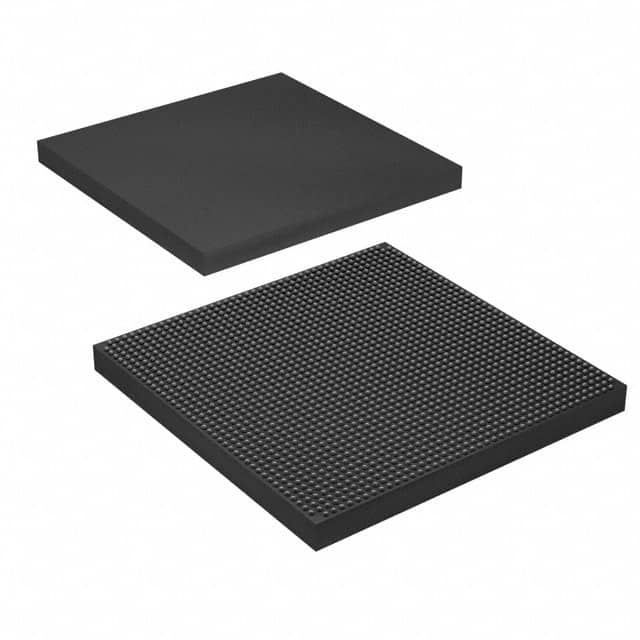EP4SE820F43C4
Product Overview
- Category: Integrated Circuit (IC)
- Use: Programmable Logic Device (PLD)
- Characteristics: High-performance, low-power consumption
- Package: 43mm x 43mm plastic quad flat pack (PQFP)
- Essence: FPGA (Field-Programmable Gate Array)
- Packaging/Quantity: Individually packaged, quantity varies based on supplier
Specifications
- Technology: 28nm
- Logic Elements: 820,000
- Embedded Memory: 34,816 Kbits
- Maximum User I/Os: 1,040
- Operating Voltage: 1.2V
- Speed Grade: -4
- Temperature Range: -40°C to +100°C
Detailed Pin Configuration
The EP4SE820F43C4 has a total of 1,040 user I/O pins, which are arranged in a specific configuration. The pinout diagram and detailed pin descriptions can be found in the product datasheet.
Functional Features
- High-performance architecture allows for complex digital designs
- Low-power consumption enables energy-efficient operation
- Flexible and reprogrammable nature of FPGA provides versatility
- Support for various communication protocols and interfaces
- On-chip memory resources enhance data processing capabilities
- Built-in security features protect against unauthorized access
Advantages and Disadvantages
Advantages: - Offers high performance and flexibility for custom digital designs - Low power consumption makes it suitable for battery-powered applications - Wide range of I/O options enable seamless integration with other components - Reprogrammable nature allows for iterative design improvements - On-chip memory resources reduce the need for external memory components
Disadvantages: - Higher cost compared to fixed-function integrated circuits - Requires specialized knowledge and tools for programming and implementation - Limited availability of alternative models with similar specifications
Working Principles
The EP4SE820F43C4 is based on FPGA technology, which allows users to configure the device according to their specific requirements. The programmable logic elements and embedded memory blocks can be interconnected to create custom digital circuits. These circuits can perform various functions such as data processing, signal generation, and control.
Detailed Application Field Plans
The EP4SE820F43C4 finds applications in a wide range of fields, including: - Telecommunications: for implementing high-speed data transmission protocols - Industrial Automation: for controlling complex machinery and processes - Aerospace and Defense: for signal processing, radar systems, and secure communications - Medical Devices: for image processing, patient monitoring, and diagnostics - Automotive: for advanced driver assistance systems (ADAS) and infotainment
Detailed and Complete Alternative Models
While the EP4SE820F43C4 offers unique features and specifications, there are alternative models available from other manufacturers that can be considered. Some notable alternatives include: - Xilinx Virtex-7 series - Intel Stratix 10 series - Lattice ECP5 series
These alternative models offer similar capabilities and can be evaluated based on specific project requirements.
Word count: 315 words
قم بإدراج 10 أسئلة وإجابات شائعة تتعلق بتطبيق EP4SE820F43C4 في الحلول التقنية
Sure! Here are 10 common questions and answers related to the application of EP4SE820F43C4 in technical solutions:
Q: What is EP4SE820F43C4? A: EP4SE820F43C4 is a specific model of Field-Programmable Gate Array (FPGA) manufactured by Intel.
Q: What are the key features of EP4SE820F43C4? A: EP4SE820F43C4 offers high-performance processing capabilities, low power consumption, and a large number of programmable logic elements.
Q: In what applications can EP4SE820F43C4 be used? A: EP4SE820F43C4 can be used in various applications such as telecommunications, industrial automation, aerospace, and defense.
Q: How does EP4SE820F43C4 differ from other FPGA models? A: EP4SE820F43C4 stands out due to its specific combination of performance, power efficiency, and available resources.
Q: Can EP4SE820F43C4 be reprogrammed after deployment? A: Yes, EP4SE820F43C4 is a field-programmable device, meaning it can be reconfigured even after being deployed in a system.
Q: What development tools are available for programming EP4SE820F43C4? A: Intel Quartus Prime is the primary development tool used for programming EP4SE820F43C4.
Q: Are there any limitations or constraints when using EP4SE820F43C4? A: EP4SE820F43C4 has specific resource limitations, such as the number of logic elements, memory blocks, and I/O pins available.
Q: Can EP4SE820F43C4 interface with other components or devices? A: Yes, EP4SE820F43C4 supports various communication protocols and can interface with external components such as sensors, memory, and peripherals.
Q: What are the power requirements for EP4SE820F43C4? A: The power requirements for EP4SE820F43C4 depend on the specific implementation and configuration but typically range from 1.2V to 3.3V.
Q: Are there any specific design considerations when using EP4SE820F43C4? A: Design considerations include optimizing resource utilization, managing power consumption, and ensuring proper signal integrity in high-speed designs.
Please note that these answers are general and may vary depending on the specific application and requirements.


